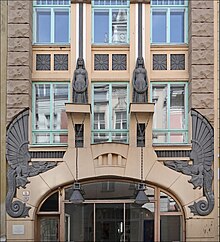Jacques Rosenbaum
From 1889 to 1896, Rosenbaum studied at the Tallinn Peter's Real School, after which he went on to the Riga Polytechnic Institute, now in Latvia.
In 1908, Rosenbaum completed a project for one Reinhold Reichmann on the corner of the two streets Pikk and Hobuspea in old town, Tallinn.
It shows influences of Art Nouveau, German neo-Renaissance and neo-Mannerism, all of which is expressed in the wealth of ornamentation.
Among the details, a comical sculpture of an old man gazing across the street through his pince-nez has given rise to plenty of local stories.
The building on Pikk 23/25 also displays Rosenbaum's ideas on town planning, in that the architect has tried to enliven the urban space through the use of a corner tower with a twisting dome, balconies and other architectural ornamentation.
The house on Pikk 23/25 was well received in the local press, and helped establish Rosenbaum as an architect in Tallinn.
In 1910, Rosenbaum completed another project for Reinhold Reichman, this time on Pikk 18 – just across the street from the earlier building.
Here again Rosenbaum started out with a proposal for a relatively strictly Art Nouveau building, but the project was revised and built in a slightly less extravagant, more traditional and historicist style.
During World War II, the building was severely damaged and in the subsequent restoration many of the sculpted details were not recreated.
In 1911–12, a tenement house for Gustav Leppenberg, a craftsman and piano-maker, was built by Rosenbaum's design on the street Roosikrantsi, number 15.
A symmetrical façade, not typical for the Art Nouveau movement, is decorated with sculpted lions' heads.
Strong influences for his style came from the Art Nouveau movement in Riga at the beginning of the 20th century, as well as Finnish national romanticism.



